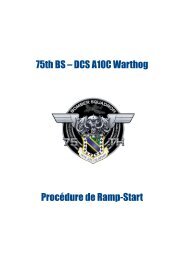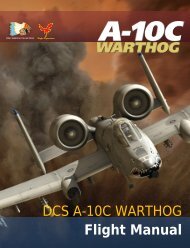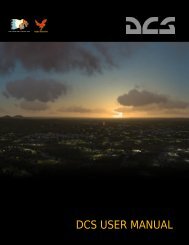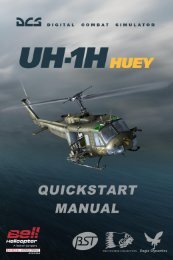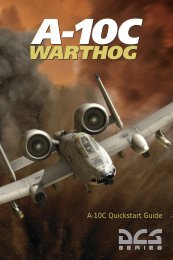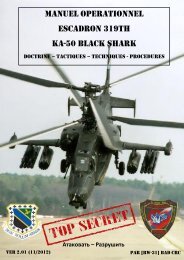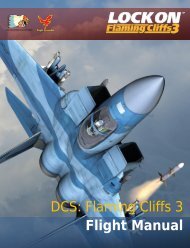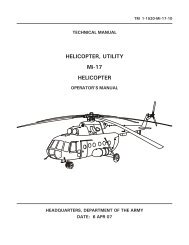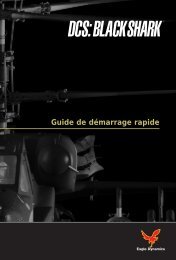You also want an ePaper? Increase the reach of your titles
YUMPU automatically turns print PDFs into web optimized ePapers that Google loves.
<strong>DCS</strong><br />
[<strong>Su</strong>-<strong>25T</strong> Frogfoot]<br />
tubes line up with the horizon. Touchdown should occur at 220-240 km/h. Proceed to lower the nose<br />
wheel by carefully pushing the stick forward, release the brake chute and engage the wheel brakes.<br />
Maintain heading down the runway centerline with smooth pedal inputs. If the aircraft veers when<br />
braking, release the brakes, correct heading and only then reapply the brakes. If the aircraft risks<br />
running off the runway at a speed of greater than 50 km/h, retract the gear, open the canopy, and<br />
perform an emergency shutdown.<br />
Crosswind Landing<br />
When performing a crosswind landing, estimate a lead angle directly to the runway threshold such<br />
that the approach can be flown with no bank or yaw. As you flare the aircraft just before touchdown,<br />
eliminate the lead angle to align the aircraft with the runway and push the stick into the wind. This<br />
will ensure that touchdown is performed with no sideslip and is corrected for the crosswind bank<br />
tendency when rolling on the runway. Once the main gear is in contact with the ground, release the<br />
pedals to center the nose wheel and quickly, but carefully lower the nose to touchdown the nose<br />
wheel. Once stabilized down the runway centerline, engage the wheel brakes. In a crosswind of<br />
greater than 4-5 m/s, the brake chute is not used as it would make it practically impossible to<br />
maintain the aircraft on the runway. If the aircraft veers when braking, release the brakes, correct<br />
heading and only then reapply the brakes.<br />
Common Landing Errors<br />
Overshoot<br />
An overshoot will occur if speed was mismanaged and the approach performed too fast or if the<br />
touchdown point was miscalculated. This will often happen when the flare is performed late, such as<br />
over the runway threshold instead of ahead of it. A significant overshoot can be dangerous and the<br />
landing should be aborted as a missed approach ("go-around").<br />
Landing Short<br />
A landing short will occur if the approach speed was too low, the flare maneuver started too early, or<br />
the aircraft was allowed to fall below the glidepath on final appoach. To correct this, increase engine<br />
thrust until optimum approach speed is reached and the aircraft is on the glidepath.<br />
Flare Too High<br />
A flare too high will occur if the flare altitude is misjudged or the stick is pulled back too much during<br />
the flare. To correct this, hold the stick steady to allow the aircraft to descend to the proper flare<br />
altitude and then pull the stick again to perform a proper flare. In a flare too high, the aircraft will<br />
likely lose airspeed and drop onto the runway, resulting in a rough touchdown and high vertical<br />
velocities stressing the airframe.<br />
Stalls and Spins<br />
If airspeed is lost in level flight, the aircraft will stall without entering a spin. It will begin a<br />
"parachute" descent while oscillating in yaw and roll. If the stick is pulled during the stall, oscillations<br />
48 SU-<strong>25T</strong> ADVANCED FLIGHT DYNAMICS MODEL



